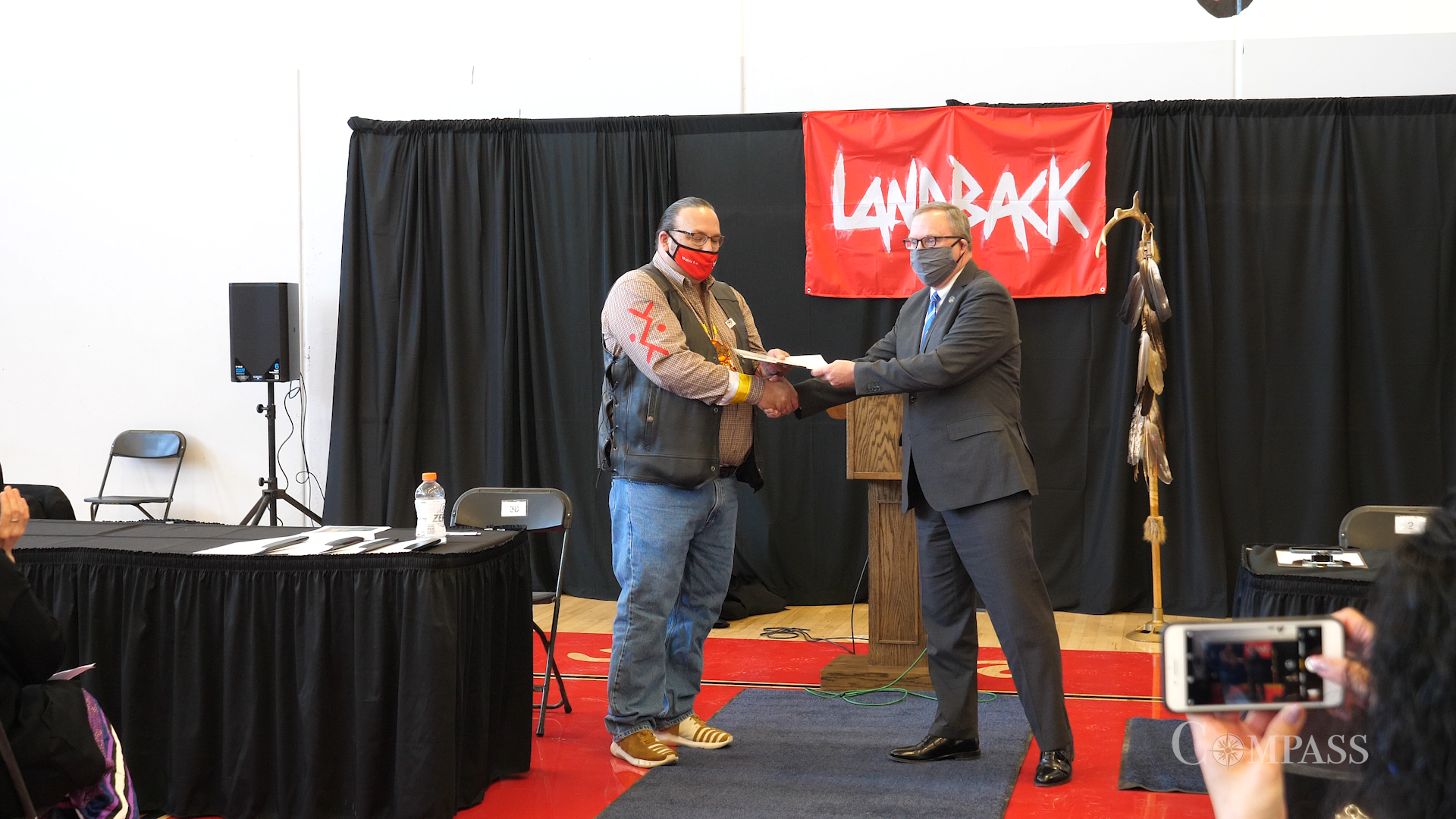The Land Back ceremony featured the signing of an agreement between the state of Minnesota, the Minnesota Historical Society and the Lower Sioux Indian Community to return 114 acres to the Lower Sioux, the original caretakers and stewards of the land. President Larson gave an emotional and candid speech to the masked and socially distant gatherers in the Cansayapi Community Center, and to over 100 people streaming the ceremony online.
"Just like to say again, thank you for being here. This is, just feel it in you, don't you?" he said, standing at the podium situation in the front of the gym.
He thanked all the Dakota relatives who came before, that made this accomplishment possible. His speech centered the importance of persistence, conversation and relationship, because ultimately, that's how people are able to have difficult conversations and move towards healing. This land return conversation started about 20 years ago but stalled after public push back.
"My father was on council back in the early 2000s, and one of them that started the conversation. It ended, unfortunately, partway through with the public comment period. The township stepped in and said they opposed so it stopped," President Larsen said. After he was elected in 2015, he had conversation with his father about starting the talks again. He talked with the rest of the Tribal council and with the Minnesota Historical Society. "It's been a very slow process, but like I said, we felt heard. And apparently we were, because it was an unanimous decision when they took their vote."
This land plays a significant role in Minnesota's history and the history of the Dakota people. The story is complex, complete with unfulfilled treaty promises and shady dealings by the United States government, but briefly and running the risk of over-simplification, this land is where Dakota people lived long before Minnesota was a state. This land is the site of the beginning of the U.S.-Dakota war. Minnesota's Lieutenant Governor Peggy Flanagan, a member of the White Earth Band of Ojibwe, recognized this during her speech.
"And although this is a joyous occasion, we cannot forget the history of these lands, and the connection to broken promises, unfulfilled treaty obligations, and the events that led to the loss of the Dakota 38+2."
(Dakota 38+2 refers to the largest mass hanging event in U.S. history, where 38 Dakota men were hanged in Mankato on December 26, 1862, after the U.S.-Dakota War. Two additional men were hanged the following day.)
Lieutenant Governor Flanagan said that when people think about "Land Back," this process is what it looks like. "It speaks to ... the real need in this moment for healing and how we move forward for the state, right? To acknowledge the role that they've had in the trauma and displacement of native people. And this is one of the ways we can be really intentional to move us towards that healing that's long overdue."
Another moving acknowledgement came from Kent Whitworth, director and CEO of the Minnesota Historical Society. He said that MNHS uses the power of history to transform lives, but this time the rules were flipped.
"What made this experience so meaningful is it was our lives, those of us in MNHS that were transformed in this process," he said. "The resilience, the graciousness of the Lower Sioux Indian Community, but also that understanding that it's not enough to be just good stewards of the land and to understand its historical significant, but we really treat it as a relative. It just really deepened our understanding and appreciation for those who went before us and their relationship to that land."
In a 20-year conversation full of complexities, Whitworth said that one of those was the Land and Water Conservation Fund known commonly as LAWCON. In order to return this acreage, which is LAWCON-desiganted land, to the Lower Sioux, a comparable amount of acreage must be given LAWCON status to replace it. "[The DNR] provided land that could be considered LAWCON property in replacement of the land that was returned to Lower Sioux. So it was DNR's generosity in many respects that enabled us to just return that land and not have to come up with financial resources ... for MNHS to purchase LAWCON replacement property."
Additionally, because of Minnesota law pertaining to the use of bond funds, the MNHS wasn't unable to transfer ownership of the Lower Sioux Interpretive Center, which is adjacent to the 114 acres returned. In his speech during the Land Back ceremony, Whitworth pledge the return of more land in the future; land that includes the Interpretive Center. "I pledge to you that MNHS is committed to working with the Tribe, in support of that transfer possibility in the future. We so look forward to the next chapter of our relationship, as together we tell a richer and a more complete history," he said.
"So we have the agreement with MHS that we're interpreting that area as visitors come," said President Larsen. "We're not trying to change that story, we're trying to add to that story. The part that people don't learn in school."
It was the thoroughness and working through these complexities and roadblocks that President Larson appreciated, because they did it the right way. "It's nice to be able to be part of the right thing, not because somebody is ordered to or we paid them enough money, but because they opened their eyes, they opened their heart, they asked the hard questions, heard the answers and decided this was the right thing to do," he said.




